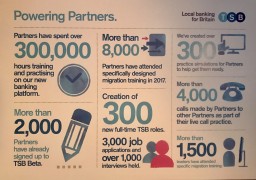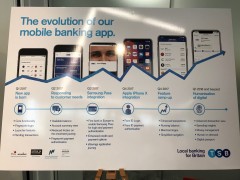TSB unveils new banking tech platform, Proteo4UK
“We have created a more digital, agile and flexible TSB,” stated Paul Pester, CEO of TSB, at the unveiling of the bank’s new technology platform, Proteo4UK.
The core originates from Proteo, the platform of TSB’s Spanish parent, Sabadell. In turn, Proteo’s roots are in the Alnova retail core banking system supplied by Accenture. Sabadell has been developing the system under its own steam for a number of years and owns the IP.
The project to build Proteo4UK has been underway for two and a half years, and some components are already in production, such as the new mobile banking app (launched in March this year) and the platform for mortgage brokers.
Customer migration is yet to come – the bank will be working on this in 2018.
Carlos Abarca, CIO of TSB, says the new system is “customer centric by design” and “enables the open banking revolution”.
“Proteo4UK was built in close co-operation with world-class companies, and has very few legacy systems,” he states. “It is a brand new core banking system for us.”
Proteo4UK is running “in a very active mode” out of two new data centres in the UK. In case of a disaster in one of the centres, all critical services will switch “with no interruption or loss of customer data, transactions or services” to the other one, Abarca explains.
Pester says the new set-up is going to save TSB over £100 million a year. At present, the bank continues to rely on Lloyds (the two were one entity until four years ago) for its core banking software, which is provided on a hosted basis and costs £220 million a year.
“We are liberating TSB by moving to the new platform,” Pester states. In addition to significant cost saving, it enables flexibility in choosing providers and partners, he explains. For example, the bank is moving all of its current account debit cards to Mastercard (farewell, Visa) in 2018 as part of a new seven-year agreement.
There are also plans to move into the SME banking segment, which will be supported by Proteo4UK. TSB is bidding for a share of the £750 million fund set up by Royal Bank of Scotland (RBS) to boost business lending in the UK (the fund replaced RBS’s failed attempt to shed 300 branches and carve out a separate bank under the Williams & Glyn brand). Pester says TSB is aiming to get three grants worth £60 million, £100 million and £20 million.
Abarca highlights the benefit of launching new products and services “at a speed that has not been seen in this country”. The bank was the first in Europe to launch the iris scan technology for its mobile app (the project is on the Banking Technology Awards 2017 shortlist); first in Europe to enable Samsung Pass for login and payment authentication; and among the first in the UK to introduce the facial recognition technology, Face ID, for Apple’s iPhone X users (for login and payment authentication).
“It’s the technology journey that we are on together with our customers,” Abarca says.
All change
The platform was built with a great deal of input from TSB’s employees – or “partners” (as the bank calls them) – says Helen Rose, the bank’s COO.
The team was careful to minimise the impact on the customer side, she says, e.g. no changes to sort codes, account numbers and so on, but for the “partners” the change was monumental.
All channels systems, all back office and internal systems (e.g. HR, ERP etc) and “every single piece of IT kit in all offices” were replaced, Rose says.
“It was a massive effort – 300,000 hours of partner training, 80,000 tests so far.” The bank has also introduced a new digital workplace solution, with video conferencing and other remote working capabilities, as well as a bring your own device (BYOD) policy. “We want to attract the best talent – and thus we are creating a work environment and culture that enables greater flexibility and productivity,” Rose states.
Going mobile
As mentioned above, TSB launched a brand new mobile app, based on Proteo4UK, in early spring this year. It is hosted on the Amazon Web Services (AWS) cloud.
Genevieve Kangurs from TSB’s digital transformation office says the app boasts “the speed, adaptability and flexibility unheard of before”. New features and enhancements are launched every month, based on customer feedback. “We listen to what our customers want,” she states.
For example, navigation has been simplified further and merchant logos have been added to transactions so a user can easily see where they spent the money.
The year 2018 and beyond will be the “humanisation of digital” for the mobile app: more use of artificial intelligence (AI), money management capabilities, a digital passport as well as other useful features (e.g. advanced transaction view and spending insights).
Thanks to agile methodology, TSB can bring to market new mobile app features in just four to six weeks, Kangurs says. In the previous environment, this took up to six months. “We have a great partnership with Sabadell and the development team in Barcelona,” she notes.
Data centralisation
TSB describes data as “the life blood of banking”. The bank has transformed its data environment to “build a foundation to respond to customer and regulations quicker”.
The previous set-up had a complex architecture, resulting in duplicate technologies, multiple data sources and heavy reliance on end-user computing (EUCs).
The new structure has simple architecture, is centralised and offers single version of truth. For example, change of address – a point of frustration for both customers and employees, as it had to be done multiple times in multiple systems – can now be done just once across all systems.
Teradata’s tech supports data acquisition, IBM Infosphere provides data integration and MicroStrategy enables data exploitation.
TSB has also invested in data quality tools and has created a data catalogue about its data (meta data).
“We can now meaningfully apply and use the data for our processes, customer services and new products,” says Kate Gallego, head of business intelligence at TSB.
















































Hasn’t gone that well then!!
Yeah… Untangling yourself from very old legacy tech is a b**ch
large corporate companies would fear migrating off mainframe
Old legacy tech that has been modernised continuously over decades and is capable of producing unsurpassed reliability availability and serviceability, open to new computing paradigms while still capable of supporting decades old applications without rewriting them every time a new variant of the application language is released.
Maybe IBM will sell them some new shiny high tech mainframes as part of their assistance.
Saw your interview on BBC vg, this May be a big migration in fintech terms but we routinely do this in my world and it looks to me like lots of governance issues in terms of readiness v risk
And how to manage hypercare. Most FMCGs have hundreds of legacy systems and thousands of APIs
This is simply an example of organisational arrogance know better culture
I agree that this is not the biggest migration out there and some other banks did something similar in a “big bang” switchover that didn’t end in this kind of mess. Organisationally, it was done very badly – no doubt about it. Telephone banking and branch banking weren’t ready with “extra padding” to take on the internet/mobile banking fall.
Also, I think the bank simply wasn’t prepared for the influx of small-value mobile and online banking transactions from their five million customers – this is what contributed to bringing the whole system down. Why not? Good question. They should have been.
But it is nevertheless a very complex, big undertaking. Wouldn’t wish it on anyone!
Well, so much for Adventure and Agile Methodology: Proteo4UK is obviously a botched system. Who was responsible for design architecture? And, more importantly: what and how thorough was testing? Clearly not enough! Yes, you can bring out a system in six weeks instead of six months, but it is: c**p!
Would appear your new wonderful system is seriously flawed, considering the problems that us poor customers are now experiencing.
It would appear that your testing process failed to appreciate the impact of such a change.
Be interesting to see how many of the 1.9 million customers stay . I won’t and I’m ex-staff who worked on the original system. Shame on you!!!
I’m a Tech Recruiter and not an Engineer so what follows may be bunkum. I suspect the major root cause of this lies with what I believe to be a migration to a Cloud (maybe BM BlueMix?) and Microservices environment. More specifically, they used guys with J2EE & WebSphere, etc. skills who grew up building solutions in monolithic environments. In their rush to go Cloudy these J2EE guys don’t yet have the expertise to build and test Microservices properly. Put another way, they’re looking at their Cloudy environment through old, monolithic prisms and have created a massive TITSUP in the process.
For an effort of this magnitude, using BlueMix & Spring Boot Microservices, you need top, top, Engineers. i. e. FAANG quality guys who ain’t cheap and don’t reside offshore. It’s all well and good jumping on the latest tech trends but if you ain’t got the staff to do the work….well,you get shit like this.
I just wonder WHO the test partner was for this migration/dcoupling of cust accounts??
I’m an customer of TSB who is now held hostage by them. Unable to transfer funds from my account back to Lloyds bank. The whole TSB system is very flacky and appears to be running on Adobe flash technology – bad design strategy. What ever TSB say or do now will never regain my trust in them. Remember, we all rely upon money to do and live our lives. Anyone who makes life more difficult in this respect is asking for heaps of trouble.
Should have leveraged OpenTracing. At least that way they could diagnose where the problems occur.